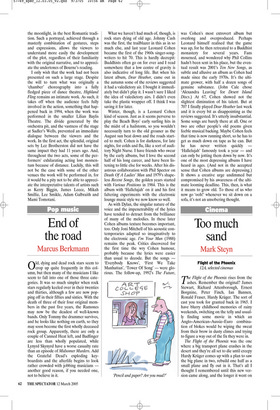Too much sand
Mark Steyn
Flight of the Phoenix 12A, selected cinemas The Flight of the Phoenix rises from the ashes. Remember the original? James Stewart, Richard Attenborough, Ernest Borgnine, Peter Finch, Ian Bannen, Ronald Fraser, Hardy Krüger. The sort of cast you took for granted back in 1965. I have blurry childhood memories of rainy weekends, switching on the telly and usually finding some movie in which an Anglo–American–Aussie–Euro combination of blokes would be wiping the sweat from their brow in dusty climes and trying to figure a way out of the fix they were in.
The Flight of the Phoenix was the one where a big transport plane crashes in the desert and they’re all set to die until creepy Hardy Krüger comes up with a plan to saw the big plane in two, rebuild one half as a small plane and fly out in it. That’s all I thought I remembered until this new version came along, and the longer it went on the more images from the Robert Aldrich original floated up out of the past. What I mainly recalled was how great Hardy Krüger was, and I haven’t consciously given him a thought in decades, and if I did I was probably confusing him with Hardy Amies.
Anyway, John Moore decided the time was ripe for a new Phoenix, so he sawed the old movie in two, rewrote one half and tries to get it to take off. Instead of the Sahara, we’re now in the Gobi Desert, somewhere in the shifting whispering sands on the Chinese/Mongolian border. In the Jimmy Stewart role, Moore has Dennis Quaid, last seen in The Day After Tomorrow, the laugh-a-minute eco-comedy in which Dick Cheney’s press conference brings on a new ice age. Presumably someone figured Quaid’s now the go-to guy for meteorological extremes: if he’s great freezing his butt off with nothing but snow for hundreds of miles, he’ll be just as good sweating buckets with nothing but sand for hundreds of miles. Sadly, he’s far less fun when you get him off the ice: in that sense, he’s less the new Jimmy Stewart than the new Sonja Henie. As hardbitten cynical pilot Frank Towns, he makes his living flying in to underperforming oil ventures, capping the wells and flying everyone out.
‘They call you “Shut ’Em Down” Towns,’ says Miranda Otto helpfully at the beginning. The first thing he shuts down is his facial expression, which is sourly clenched throughout — either that or he got a touch of frostbite during the Dick Cheney ice age and it hasn’t thawed out yet. Despite the lavish special effects in the interminable crash sequence, you’re left with the vague impression that he’s nosedived into the sand because he was in a bad mood.
So he gets his just desserts, which is just desert stretching as far as the eye can see. In 1965, they had a real plane, and the stuntman flying it — the great Paul Mantz — crashed it and died. But, except for his contributions, the film was all acting: just the wreckage in a sandpit and a great human drama going on around it. Now we have computers, so when in doubt John Moore throws in more sand. Things getting a bit slow? No problem, instant sandstorm blows in. Can’t find a way to kill off Third Minor Character From The Right? Watch out, here comes a ton of sand. They’re building the plane too fast and you need to set ’em back? Not to worry, bury it in sand. Sand, sand everywhere. About 90 minutes in, I got so itchy I could have sworn it had got in my shorts.
The desert may blow you away but the players don’t. It’s the usual Benetton-ad casting: there’s a Mexican–American chef and a Scots oil worker and a black co-pilot and an atheist Saudi who reminded me of Topol at all the wrong moments. There’s a small Mongol horde that wants to kill ’em, but Moore uses them mainly as a novelty act while he’s waiting for the next truckload of sand. And there’s a company suit played by Hugh Laurie, who comes nearest to the spirit of the original. Today we mock the over-familiar ensemble approach that was standard in Robert Aldrich’s day, but guys like Ernest Borgnine and Peter Finch have incredible presence and Moore could have used a little of that. Casting good but unknown actors only underlines how little there is to the characters. Giovanni Ribisi, as the nerdy dweeby geeky egghead with the plan to build a new plane, is called Elliott but manages to be almost as sinisterly Teutonic as Hardy Krüger. He has rimless Gestapo specs and an Aryan blond dye job. So the construction of the Phoenix is a race against time, as they have to get back to civilisation before his roots begin to show.
Miss Otto plays the lead oil engineer or, to use the technical term, The Girl. In the original, the only woman was a briefly glimpsed mirage, so in theory the addition of an Aussie lovely ought to improve things. At the crucial moment, one assumes, she’ll save the day by using the underwiring from her bra to hold the propeller in place. But Miss Otto is a fully paid-up member of the Amalgamated Union of Action-Flick Chicks and, under their new guidelines, the lovelier you are the more you grimace your way through the movie, the curvier your form the more you slouch around in shapeless overalls and work shirts. So she matches Dennis Quaid scowl for scowl, and, if you’re thinking a topless scene wouldn’t go amiss in this movie, you’ll have to make do with Dennis taking his shirt off, which the camera lingers on somewhat gratuitously. Horses sweat, men perspire, but Dennis just glows. Time to get back on the ice.


































































 Previous page
Previous page